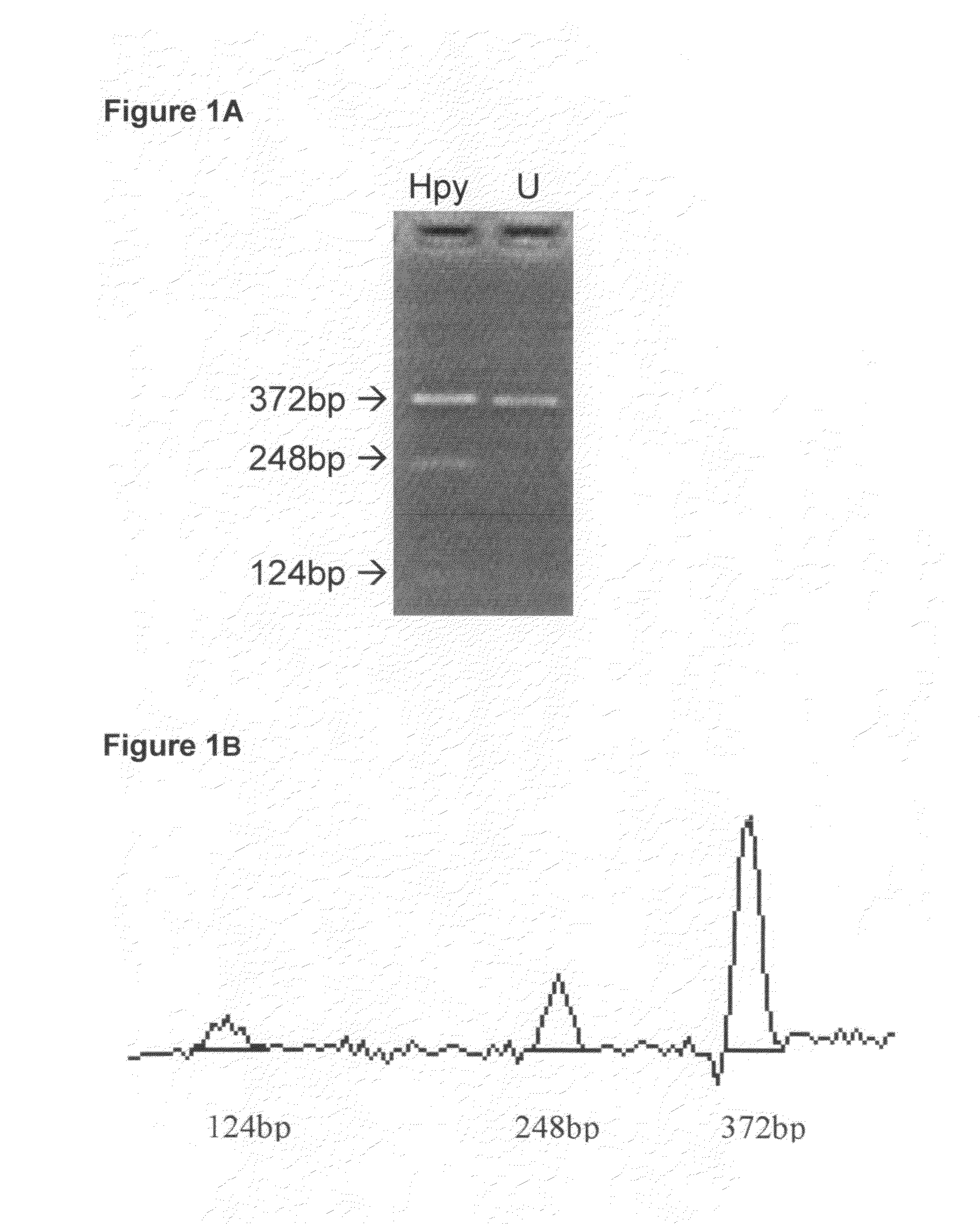Simple algorithm for quantifying polymorphisms in electropherograms
a polymorphism and electropherogram technology, applied in the field of simple algorithm for quantifying polymorphisms in electropherograms, can solve the problems of chromosomes being hard to unwind, chromosomes being difficult to unwind, and chemical modifications can interfere with the machinery of protein production, etc., to achieve the effect of simple, cost-effective and accura
- Summary
- Abstract
- Description
- Claims
- Application Information
AI Technical Summary
Benefits of technology
Problems solved by technology
Method used
Image
Examples
example 1
[0079]FIG. 1 shows a COBRA gel for measuring methylation of an HpyCH4IV site (ACGT) and the corresponding site in the sequencing electropherogram. In this and other COBRA gels, the amounts of digest loaded were in a moderate range so that the bands were at a gray level (in an approximately linear range) and still gave a substantial signal. FIG. 2A is a regression plot of COBRA values versus electropherogram values at the ACGT site, and shows a high correlation (0.95) between values measured by the two methods. FIG. 2B is a Bland-Altman plot for this same data. The mean (SD) difference between COBRA and Mquant values for the HpyCH4IV site was +0.72% (7.6%), indicating little evidence for bias (P=0.68) between methods. The outside horizontal lines of FIG. 2B show the Bland-Altman 95% LoA's, which are (−14.4%, +15.9%) for the ACGT site. The mean values of percent methylation for COBRA and Mquant were 31.6% and 32.4% respectively. Overall, these results show that the two methods tend to...
example 2
[0080]FIGS. 3 through 4B show analogous results for the Taqalphal site (TCGA). The correlation between methylation levels measured by the two methods was somewhat lower (0.91). The mean (SD) difference between values measured by COBRA versus Mquant was −8.9% (10.3%), indicating statistically significant evidence (P<0.0001) of a bias toward lower values as measured by Mquant compared to COBRA. The 95% LoA's were (−29.5%, +11.7%) for the TCGA site. The mean values of percent methylation for COBRA and Mquant were 61% and 52% respectively. Although the bias was statistically significant at the Taqalphal site, it was nevertheless under 10% methylation.
example 3
[0081]FIGS. 5 through 6B show analogous results for the Acil sites (GCGG). The correlation between methylation levels measured by the two methods was high (0.98). The mean (SD) difference between values measured by COBRA versus Mquant was 1.6% (8.1%), indicating little evidence for bias (P=0.48) between methods. The 95% LoA's were (−14.6%, +17.8%) for the GCGG site. The mean values of percent methylation for COBRA and Mquant were 61% and 63% respectively. Overall, these results show that the two methods tend to agree well at the Acil site.
[0082]Inventor made estimates of C to T conversion levels and general noise levels in the electropherograms. First, Inventor measured the C level under Ts from nonCpG Cs. These levels were small and indicated a conversion rate of >93% to 97%. Next, Inventor measured the levels of other bases (G and A) under Ts from nonCpG Cs. Levels of G and A were similar to those of C indicating that a substantial amount of C level may come from sequencing noise ...
PUM
| Property | Measurement | Unit |
|---|---|---|
| area | aaaaa | aaaaa |
| T signal-to-noise ratio | aaaaa | aaaaa |
| fluorescent dye terminator sequencing | aaaaa | aaaaa |
Abstract
Description
Claims
Application Information
 Login to View More
Login to View More - R&D
- Intellectual Property
- Life Sciences
- Materials
- Tech Scout
- Unparalleled Data Quality
- Higher Quality Content
- 60% Fewer Hallucinations
Browse by: Latest US Patents, China's latest patents, Technical Efficacy Thesaurus, Application Domain, Technology Topic, Popular Technical Reports.
© 2025 PatSnap. All rights reserved.Legal|Privacy policy|Modern Slavery Act Transparency Statement|Sitemap|About US| Contact US: help@patsnap.com



